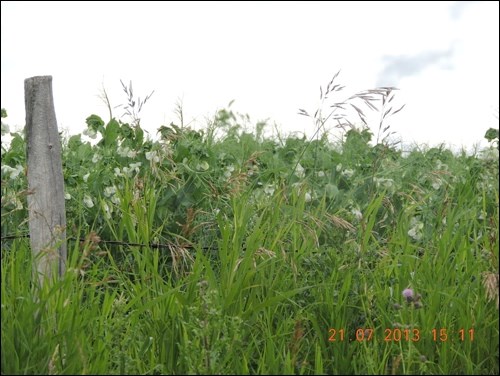Fall frost can be detrimental to crops especially if development has been delayed. The extent of damage depends on temperature, length of exposure time, humidity levels, speed to which the freezing temperature was reached, developmental stage and type of crop.
In order to understand the effects of frost one must understand plant cells. Plant cells contain not only water but also proteins, sugars, amino acids and other solutes that can lower the freezing temperature and protect cells against intracellular ice formation; similar to antifreeze in your car. Therefore, even though water freezes at zero degrees Celsius a plant cell may need lower temperatures before the cells will freeze.
Different types of crops, stages of development, and plant parts, can have varying levels of these 'antifreeze' compounds that result in a range of susceptibility to frost. Environmental conditions such as drought, cold temperatures, heat, etc. can influence levels of these compounds, and thus affect tolerance to freezing temperatures. Typically, when a plant is exposed to stress it becomes more hardened which can moderately increase the tolerance to frost. Frost damage occurs as moisture within the plant crystallizes and expands. This causes cells to rupture and fluid to leak out thus, the watery appearance of plant tissue or seed after a damaging frost.
Heavy dew can protect plants from frost but only for a period of time. As the dew freezes it gives off heat which protects the plants. Once the dew is frozen there is no longer any protection and the colder the temperature or the longer the duration of the frost, the higher the likelihood of damage.
Crops vary in tolerance to freezing temperatures with flax being quite tolerant, followed by cereals, pulses and then canola. It is not only the crop type, but the stage of development that has an impact on damage that can occur from frost. Early stages of seed development have higher water content that makes them more susceptible to frost damage. As seeds develop and reach physiological maturity, the water content decreases and the seeds are less damaged by freezing temperatures. For example, cereal plants exposed to frost at the late dough stage sustain far less injury than plants exposed at milk stage. Injury can involve reductions in yield, quality, germination, and/or vigor. Later stages of development are affected less in yield but there can still be quality, germination and vigour issues. Seed exposed to frost should be checked for germination and vigour prior to consideration of planting it the following year.
Looking for damage caused by frost is time sensitive and tricky to do. Frost damage with cereals first appears as soft watery kernels that ooze water upon squeezing. This is evident at the milk and early dough stages and can be seen within a couple days of the frost. With frost damage at these stages the kernels will shrink and become very light. At earlier stages, such as kernel development, the damage is harder to identify and may take longer to access. The developing kernels contain a lot of moisture normally, so the method does not work as well. It may take up to seven to ten days to truly evaluate the damage. The developing kernels are halted in development and will become soft and start to shrink. At later stages of development such as mid to late dough stages, frost damage occurs in the form of bran frost with potential for shrinkage. This is not evident until at least seven to ten days.
With canola and mustard it is important to assess the damage as shattering can occur. Swathing immediately can save the frozen seed, at later development stages, but may be too early for the undamaged seed. Delaying swathing can result in shattering so it is critical to make a proper assessment of the field and swath accordingly. Assessing the field in terms of damaged versus undamaged seed is best done two to three days after the frost or later. To evaluate whether there is frost damage in canola, look for the immature seeds to shrink and no longer be firm. They will become watery masses and will look like pepper once they have dried. The more mature kernels will remain hard but will retain the green color causing quality reductions. If the majority of the seed is damaged, swath the crop immediately. If not, leave to proper swathing stage. Note that if the crop has frozen and the pods have turned white, the crop should be swathed as quickly as possible as pods will start to shatter.
In summary, frost is very hard to predict in terms of damage potential in the crop. Evaluating the damage is difficult and should be done approximately 24 to 48 hours after the frost for initial symptoms and up to seven to ten days for full extent of damage. A white appearance in canola or mustard is a good early indicator of some frost damage. Heavily damaged crops will quickly show signs of frost injury including discoloration and darkening, as well as a water soaked appearance of fleshy tissue and pods. Slightly damaged pods or heads may show very little symptoms, but the seeds within the heads may be damaged. Knowing the level of potential damage can help with decisions for harvest and with marketing the grain. Hopefully the crops will be past the susceptible stage before the first fall frost, but there always seems to be some that do get affected.
For more information on this, or other crops related topics, contact Sherrilyn Phelps at 306)-446-7475 or the Agriculture Knowledge Centre at 1-866-457-2377.
- Phelps is Regional Crops Specialist, North Battleford Regional Services Branch




